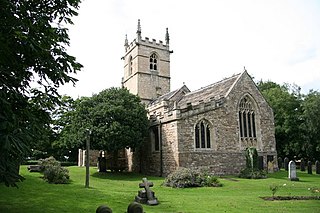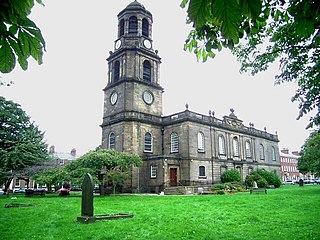
South Mimms is a village and former civil parish, now in the parish of South Mimms and Ridge, in the borough of Hertsmere in Hertfordshire in the East of England. It is a small settlement located near to the junction of the M25 motorway with the A1(M) motorway. In 2011 the parish had a population of 855.

Normanton is a town and civil parish in the City of Wakefield in West Yorkshire, England. It is north-east of Wakefield and south-west of Castleford. The civil parish extends west and north to the River Calder, and includes the large village of Altofts. At the time of the 2011 Census, the population of the civil parish was 20,872.

Newland with Woodhouse Moor is a civil parish in the City of Wakefield in West Yorkshire, England, consisting of some open countryside west of Normanton, including Newland Hall.

Altofts is a village in West Yorkshire, England. It lies 5 miles (8 km) north-east from the centre of Wakefield and less than 1 mile (1.6 km) north-west of Normanton. The M62 runs close to the village to the north-east, and the Aire and Calder Navigation to the north-west.

St James' Church, High Melton is a parish church of the Church of England in High Melton, South Yorkshire, England.

Levett is a surname of Anglo-Norman origin, deriving from [de] Livet, which is held particularly by families and individuals resident in England and British Commonwealth territories.

Sir Thomas Gargrave (1495–1579) was an English Knight who served as High Sheriff of Yorkshire in 1565 and 1569. His principal residence was at Nostell Priory, one of many grants of land that Gargrave secured during his lifetime. He was Speaker of the House of Commons and vice president of the Council of the North.
Thomas Levett, was an Oxford-educated Lincoln's Inn barrister, judge of the Admiralty for the Northern Counties and High Sheriff of Rutland. But Levett's chief accomplishment was as antiquarian, preserving a centuries-old chartulary kept by Cluniac monks at their Pontefract, Yorkshire abbey, and then turning it over to Yorkshire medieval scholar Roger Dodsworth for publication.

Lancaster Priory, formally the Priory Church of St Mary, is the Church of England parish church of the city of Lancaster, Lancashire, England. It is located near Lancaster Castle and since 1953 has been designated a Grade I listed building. It is in the deanery of Lancaster, the archdeaconry of Lancaster and the Diocese of Blackburn. Its benefice is combined with that of St John and St Anne.

Wakefield Cathedral, or the Cathedral Church of All Saints in Wakefield, West Yorkshire, England, is a co-equal Anglican cathedral with Bradford and Ripon Cathedrals, in the Diocese of Leeds and a seat of the Bishop of Leeds. Originally the parish church, it has Anglo Saxon origins and, after enlargement and rebuilding, has the tallest spire in Yorkshire. Its 247-foot (75 m) spire is the tallest structure in the City of Wakefield. The cathedral was designated a Grade I listed building on 14 July 1953.

All Saints' Church is a 15th-century redundant church in the park of Harewood House, the seat of the Lascelles Earls of Harewood, near the village of Harewood, West Yorkshire, England.

All Saints, Frindsbury, is a parish church serving the combined parish of Frindsbury with Upnor and Chattenden. The church dates from 1075 and lies in the north-west corner of the Medway Towns, historically part of Kent, England. It is a Grade II* listed building, National Heritage List number 1107886.

All Saints Church is a parish church in Hollingbourne, Kent. It was begun in the 14th century and is a Grade I listed building. The church contains numerous monuments to the local Culpeper family.

All Saints is a parish church in Ulcombe, Kent. It was begun in the 12th century and is a Grade I listed building.

William Swinden Barber FRIBA, also W. S. Barber or W. Swinden Barber, was an English Gothic Revival and Arts and Crafts architect, specialising in modest but finely furnished Anglican churches, often with crenellated bell-towers. He was based in Brighouse and Halifax in the West Riding of Yorkshire. At least 15 surviving examples of his work are Grade II listed buildings, including his 1875 design for the Victoria Cross at Akroydon, Halifax. An 1864 portrait by David Wilkie Wynfield depicts him in Romantic garb, holding a flower. He served in the Artists Rifles regiment in the 1860s alongside Wynfield and other contemporary artists.

The Grade I listed, mainly Norman Church of Saint John the Baptist in Adel, Leeds, West Yorkshire, England has been described by Nicholas Pevsner as 'one of the best and most complete Norman churches in Yorkshire'. It is most notable for its magnificent south doorway with surrounding carvings, and highly carved Norman chancel arch. There is also a replica of a 13th-century sanctuary ring on the exterior of the south door, the original having unfortunately been stolen in 2002. The church is an active Anglican parish church in the archdeaconry of Leeds and the Diocese of Leeds.

The Anglican Church of All Saints in Long Ashton was built in the 14th century although much of the fabric was rebuilt in the 1870s. It is a Grade II* listed building.

The Church of All Saints in Radwell in Hertfordshire is an Anglican parish church which falls within the Diocese of St Albans. It is a Grade II* listed building, having gained that status in 1968.

The Church of Saint John the Baptist in Wakefield, West Yorkshire, England is an active Anglican parish church in the archdeaconry of Wakefield and the Diocese of Wakefield. The church is Grade II* listed and has been since 30 March 1971. St John's is the smaller of the Anglican churches in Wakefield City Centre, the larger being Wakefield Cathedral.



















